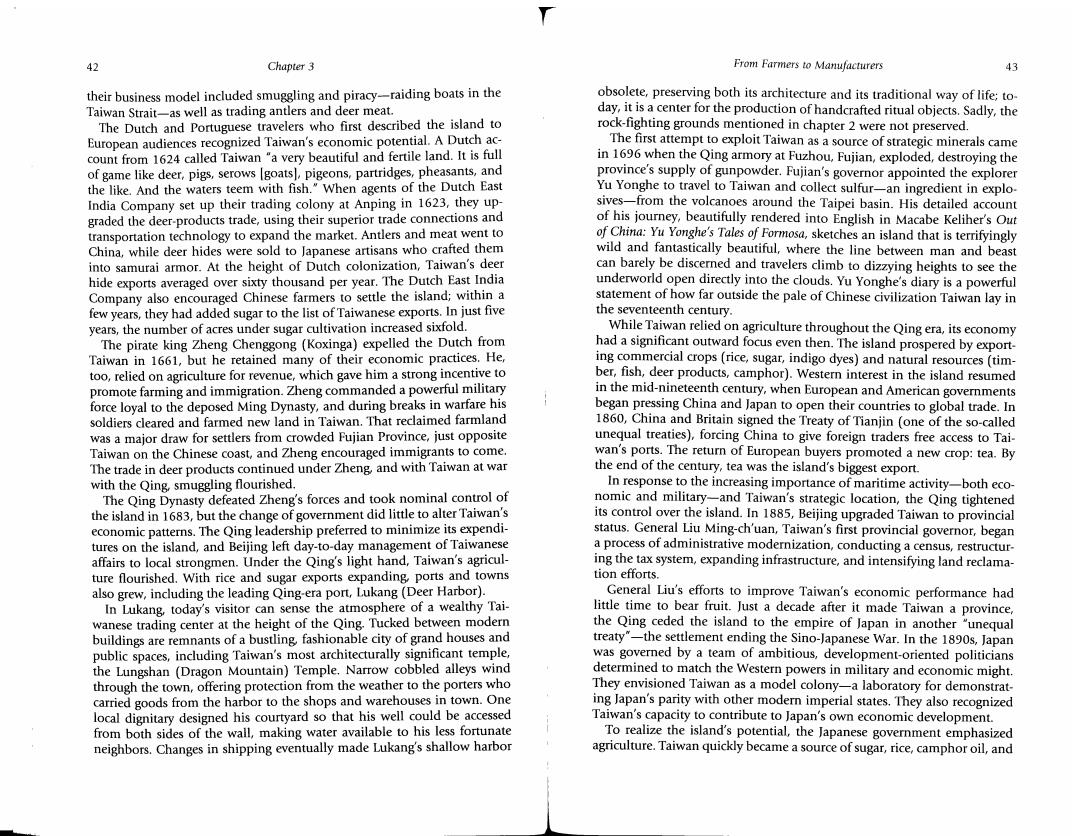正在加载图片...

42 Chapter 3 From Farmers to Manufacturers 43 their business model included smuggling and piracy-raiding boats in the obsolete,preserving both its architecture and its traditional way of life;to- Taiwan Strait-as well as trading antlers and deer meat. day,it is a center for the production of handcrafted ritual objects.Sadly,the The Dutch and Portuguese travelers who first described the island to rock-fighting grounds mentioned in chapter 2 were not preserved. European audiences recognized Taiwan's economic potential.A Dutch ac- The first attempt to exploit Taiwan as a source of strategic minerals came count from 1624 called Taiwan "a very beautiful and fertile land.It is full in 1696 when the Qing armory at Fuzhou,Fujian,exploded,destroying the of game like deer,pigs,serows lgoats],pigeons,partridges,pheasants,and province's supply of gunpowder.Fujian's governor appointed the explorer the like.And the waters teem with fish."When agents of the Dutch East Yu Yonghe to travel to Taiwan and collect sulfur-an ingredient in explo- India Company set up their trading colony at Anping in 1623,they up- sives-from the volcanoes around the Taipei basin.His detailed account graded the deer-products trade,using their superior trade connections and of his journey,beautifully rendered into English in Macabe Keliher's Out transportation technology to expand the market.Antlers and meat went to of China:Yu Yonghe's Tales of Formosa,sketches an island that is terrifyingly China,while deer hides were sold to Japanese artisans who crafted them wild and fantastically beautiful,where the line between man and beast into samurai armor.At the height of Dutch colonization,Taiwan's deer can barely be discerned and travelers climb to dizzying heights to see the hide exports averaged over sixty thousand per year.The Dutch East India underworld open directly into the clouds.Yu Yonghe's diary is a powerful Company also encouraged Chinese farmers to settle the island;within a statement of how far outside the pale of Chinese civilization Taiwan lay in few years,they had added sugar to the list of Taiwanese exports.In just five the seventeenth century. years,the number of acres under sugar cultivation increased sixfold. While Taiwan relied on agriculture throughout the Qing era,its economy The pirate king Zheng Chenggong(Koxinga)expelled the Dutch from had a significant outward focus even then.The island prospered by export- Taiwan in 1661,but he retained many of their economic practices.He, ing commercial crops(rice,sugar,indigo dyes)and natural resources(tim- too,relied on agriculture for revenue,which gave him a strong incentive to ber,fish,deer products,camphor).Western interest in the island resumed promote farming and immigration.Zheng commanded a powerful military in the mid-nineteenth century,when European and American governments force loyal to the deposed Ming Dynasty,and during breaks in warfare his began pressing China and Japan to open their countries to global trade.In soldiers cleared and farmed new land in Taiwan.That reclaimed farmland 1860,China and Britain signed the Treaty of Tianjin (one of the so-called was a major draw for settlers from crowded Fujian Province,just opposite unequal treaties),forcing China to give foreign traders free access to Tai- Taiwan on the Chinese coast,and Zheng encouraged immigrants to come. wan's ports.The return of European buyers promoted a new crop:tea.By The trade in deer products continued under Zheng,and with Taiwan at war the end of the century,tea was the island's biggest export. with the Qing,smuggling flourished. In response to the increasing importance of maritime activity-both eco- The Qing Dynasty defeated Zheng's forces and took nominal control of nomic and military-and Taiwan's strategic location,the Qing tightened the island in 1683,but the change of government did little to alter Taiwan's its control over the island.In 1885,Beijing upgraded Taiwan to provincial economic patterns.The Qing leadership preferred to minimize its expendi- status.General Liu Ming-ch'uan,Taiwan's first provincial governor,began tures on the island,and Beijing left day-to-day management of Taiwanese a process of administrative modernization,conducting a census,restructur- affairs to local strongmen.Under the Qing's light hand,Taiwan's agricul- ing the tax system,expanding infrastructure,and intensifying land reclama- ture flourished.With rice and sugar exports expanding,ports and towns tion efforts. also grew,including the leading Qing-era port,Lukang (Deer Harbor). General Liu's efforts to improve Taiwan's economic performance had In Lukang,today's visitor can sense the atmosphere of a wealthy Tai- little time to bear fruit.Just a decade after it made Taiwan a province, wanese trading center at the height of the Qing.Tucked between modern the Qing ceded the island to the empire of Japan in another "unequal buildings are remnants of a bustling,fashionable city of grand houses and treaty"-the settlement ending the Sino-Japanese War.In the 1890s,Japan public spaces,including Taiwan's most architecturally significant temple, was governed by a team of ambitious,development-oriented politicians the Lungshan (Dragon Mountain)Temple.Narrow cobbled alleys wind determined to match the Western powers in military and economic might. through the town,offering protection from the weather to the porters who They envisioned Taiwan as a model colony-a laboratory for demonstrat- carried goods from the harbor to the shops and warehouses in town.One ing Japan's parity with other modern imperial states.They also recognized local dignitary designed his courtyard so that his well could be accessed Taiwan's capacity to contribute to Japan's own economic development. from both sides of the wall,making water available to his less fortunate To realize the island's potential,the Japanese government emphasized neighbors.Changes in shipping eventually made Lukang's shallow harbor agriculture.Taiwan quickly became a source of sugar,rice,camphor oil,and